Toyota Grand Highlander (AS10) 2024 Owners Manual / Driving / Before driving / Trailer Tongue Weight
Toyota Grand Highlander (AS10): Trailer Tongue Weight
- A recommended tongue weight varies in accordance with the types of trailers or towing as described below.
- To ensure the recommended values shown below, the trailer must be loaded by referring to the following instructions.
- Tongue Weight
The gross trailer weight should be distributed so that the tongue weight is 9% to 11%.
(Tongue weight/Gross trailer weight x 100 = 9% to 11%)
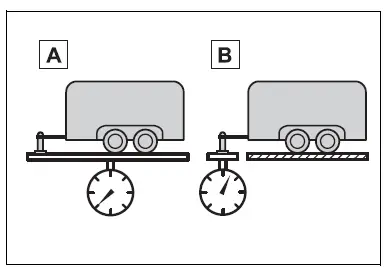
- Gross trailer weight
- Tongue weight
If using a weight distributing hitch when towing, return the front axle to the same weight as before the trailer connection.
If front axle weight cannot be measured directly, measure the front fender height above the front axle before connection. Adjust weight distributing hitch torque until front fender is returned to the same height as before connection.
The gross trailer weight, gross axle weight and tongue weight can be measured with platform scales found at a highway weighing station, building supply company, trucking company, junk yard, etc.
Hitch
Trailer hitch assemblies have different weight capacities. Toyota recommends the use of Toyota hitch/bracket for your vehicle. For details, contact your Toyota dealer.
- If you wish to install a trailer hitch, contact your Toyota dealer.
- Use only a hitch that conforms to the gross trailer weight requirement of your vehicle.
- Follow the directions supplied by the hitch manufacturer.
- Lubricate the hitch ball with a light coating of grease.
- Remove the hitch ball whenever
you are not towing a
trailer. Remove the trailer
hitch if you do not need it.
After removing the hitch, seal any mounting hole in the vehicle body to prevent entry of any substances into the vehicle.
WARNING
■Hitches
Trailer hitch assemblies have different weight capacities established by the hitch manufacturer.
Even though the vehicle may be physically capable of towing a higher weight, the operator must determine the maximum weight rating of the particular hitch assembly and never exceed the maximum weight rating specified for the trailer-hitch. Exceeding the maximum weight rating set by the trailer-hitch manufacturer can cause an accident resulting in death or serious personal injuries.
NOTICE
■When installing a trailer hitch
Use only the position recommended by your Toyota dealer.
Do not install the trailer hitch on the bumper; this may cause body damage.
Selecting trailer ball
Use the correct trailer ball for your application.
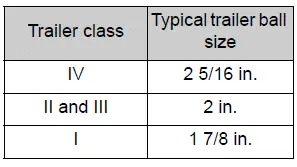
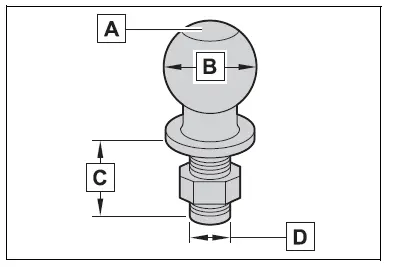
- Trailer ball load rating Matches or exceeds the gross trailer weight rating of the trailer.
- Ball diameter
Matches the size of the trailer coupler.Most couplers are stamped with the required trailer ball size.
- Shank length
Protrudes beyond the bottom of the lock washer and nut by at least 2 threads. - Shank diameter
Matches the ball mount hole diameter size.
Positions for towing hitch receiver and hitch ball
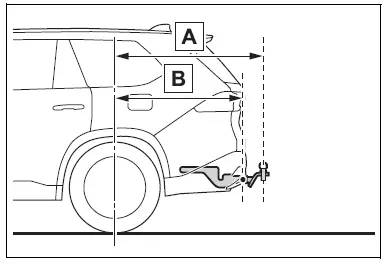
- Weight carrying ball position: 50.63 in. (1286 mm)
- Hitch receiver pin hole position: 44.25 in. (1124 mm)
Connecting trailer lights (if equipped)
Use the wire harness stored in the rear end under body.
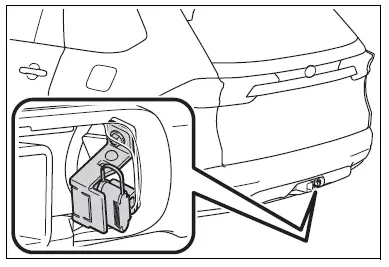
■Auto current cut-off function
In case of over current, the auto cut-off function stops the power flowing to the trailer lights to prevent damage to the vehicle's electrical system.
This function is activated when the rated current of any of the following trailer light circuit components is exceeded:
- Tail lights: maximum 8.0 A
- Stop/turn signal light (right): maximum 5.0 A
- Stop/turn signal light (left): maximum 5.0 A
■When the auto current cut function is activated
If a trailer light does not come on due to the activation of the auto current cut function, the light system will need to be reset.
Follow the reset procedure shown below.
- If a tail light does not come on, turn off the headlight switch.
- If the right-side stop/turn signal light does not come on, put the turn signal in the off position or remove foot from the brake pedal.
- If the left-side stop/turn signal light does not come on, put the turn signal in the off position or remove foot from the brake pedal.
If the emergency flashers do not operate, press the emergency flasher switch to turn them off.
After the light system is reset, operate the light switches again to see if the lights operate normally.
If the lights do not operate normally, have the vehicle inspected by your Toyota dealer.
NOTICE
■Do not directly splice trailer lights
Do not directly splice trailer lights.
Directly splicing trailer lights may damage your vehicle's electrical system and cause a malfunction.
Similar pages:
Driving position memory
This feature automatically
adjusts the driver's seat,
outside rear view mirrors
and head-up display (if
equipped) to make entering
and exiting the vehicle easier
or to suit your preferences.
Up to 2 different driving
positions can be recorded.
Each electronic key can be
registered to recall your p ...
Checking the coolant
■ Engine coolant reservoir
The coolant level is satisfactory
if it is between the "MAX" and
"MIN" lines on the reservoir
when the engine is cold.
Reservoir cap
"MAX" line
"MIN" line
■ Intercooler coolant reservoir
The coolant level is satisfactory
if it is between the "FULL" and
"LOW" line ...


